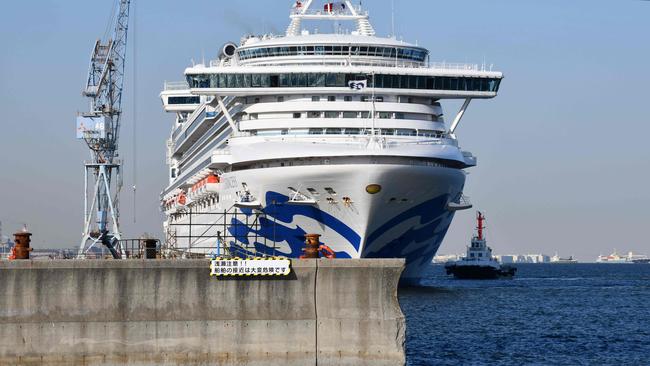Alan Jones: There must be a way out of this COVID-19 nightmare
Without a road map to get us back in business, Australia’s lockdowns look headed down a dead end that will kill the economy. New figures suggest there is a better way, writes Alan Jones.
Opinion
Don't miss out on the headlines from Opinion. Followed categories will be added to My News.
The emerging and disconcerting issue in relation to this coronavirus, and it’s an issue which cannot be put to one side, concerns one simple question, when will this end?
Everyone appreciates what is being done by Prime Minister Scott Morrison and his team.
They also appreciate the difficulty of determining when we will return to some sense of normal.
Six months is frightening people who don’t have a pay cheque banked every two weeks, like public servants, politicians and the ABC.
People are very much at odds with this business of being locked up.
If the problem with a virus is that it attacks people with a weak immune system, how on Earth do people strengthen that sitting in front of TV and unable to walk in the park, dive in the ocean or lie in the sun.
As one accomplished lawyer said to me: “What is worse, many skills will atrophy and businesses will fall into irrevocable ruin if this keeps going into June.”
It’s more than a cliche to argue that the cure could be worse than the disease.

Because if the cure involves torching the economy, hundreds of billions of dollars of government debt, even more billions in wealth destroyed with the long-term effects on entrepreneurship, together with mass unemployment, the loss of freedoms and the accumulated mental health effects of the so-called cure, then to continue on this path for six months could prove to be the greatest and most costly mistake in our nation’s history.
We have been reminded all through this sorry chapter in the nation’s history to “listen to the experts”.
But there are some experts, it seems, to whom we choose not to listen.
FOLLOW THE SCIENCE
Professor Peter Collignon is an infectious disease expert from the Australian National University.
He argues that social restrictions on people sitting on a park bench or walking on a beach don’t make biological sense.
Prof Collignon has argued: “You are safer outside than inside … I do not see how anyone is going to get this virus if they keep 2m away from someone. And I don’t see how anyone is going to get it if they sit on a park bench … My real worry is if we overdo it now, we will have people, particularly in their 30s and 40s, who will say ‘stuff this’.”
He added: “I think this is not sustainable for six months. We do have to do everything we can to minimise the spread to others, but do not do things that don’t make biological sense.”
Well, if we are to listen to the “experts”, Prof Collignon is not on his own.
Dr Joel Kettner is the Professor of Community Health Sciences and Surgery at Manitoba University in Canada.
He argues: “I have seen pandemics, one every year. It’s called influenza and other respiratory illness viruses. I have never seen this reaction and I’m trying to understand why.”
Let’s face it, 430 people die in Australia every day.
Dr David Katz, the founding director of the Yale University Prevention Research Centre argues: “I am deeply concerned that the social, economic and public health consequences of this near-total meltdown of normal life will be long-lasting and calamitous, possibly graver than the direct toll of the virus itself … the unemployment, impoverishment and despair likely to result will be public health scourges of the first order.”
Frank Ulrich Montgomery is a radiologist and former president of the German Medical Association.
He argues: “I am not a fan of lockdown. Anyone who imposes something like this must also say when and how to pick it up again.”

John Ioannidis is a Professor of Medicine and a Professor of Epidemiology and Population Health at the Stanford University School of Medicine. He argued recently: “The data collected so far on how many people are infected and how the epidemic is evolving are unreliable …. reported case fatality rates, like the official 3.4 per cent rate from the World Health Organisation cause horror and are meaningless.”
He writes: “The one situation where an entire, closed population was tested was the Diamond Princess cruise ship and its quarantined passengers. The case fatality rate there was 1 per cent, but this was a largely elderly population in which the death rate from coronavirus is much higher … projecting the Diamond Princess mortality rate on to the age structure of the American population, the death rate among people infected with the coronavirus would be 0.125 per cent … there were just seven deaths among the 700 infected passengers and crew.”

Prof Ioannidis makes the further point: “A population-wide case fatality rate of 0.05 per cent is lower than seasonal influenza. If that is the true rate, locking down the world with potentially tremendous social and financial consequences may be totally irrational.”
NEW YORK STATE OF MIND
In the last week, there has been much attention on New York.
The New York City Health Department publishes a daily report on the number of deaths.
It breaks them down into age, sex and where in the city they have occurred.
The report also lists, “underlying conditions” and “underlying conditions pending”.
As at 5pm last Saturday, New York time, there had been 2254 deaths but 1498 of those had an underlying condition, like diabetes, lung disease, cancer, heart disease, asthma or kidney disease.
In other words, more than 66 per cent of the deaths had an underlying condition; another 721, nearly 32 per cent of the total, had “underlying conditions pending”.

In terms of the remaining 35 deaths, 1.55 per cent of the total, there was no underlying condition.
Back to Prof Ioannidis, an “expert”: “If we had not known about a new virus out there and had not checked individuals with PCR tests … (PCR is an acronym for Polymerase Chain Reaction Test, which is a test used to identify the presence of a particular parasite), the number of total deaths due to ‘influenza-like illness’ would not seem unusual this year. At most, we might have casually noted that flu this season seems to be a bit worse than average. The media coverage would have been less than for an NBA game between the two most indifferent teams.”
Prof Ioannidis also makes this point: “The novel coronavirus is a serious threat. We need to prepare, not overreact …. if the health system does become overwhelmed, the majority of the extra deaths may not be due to coronavirus but to other common diseases and conditions such as heart attacks, strokes, trauma, bleeding and the like that are not adequately treated.”
FOCUS ON SUSTAINABILITY
The reality is we don’t know how long social-distancing measures and lockdowns can be maintained without major consequences to the economy, society and mental health.
Can we survive with lockdowns of months, if not years, where life largely stops, short-term and long-term consequences are entirely unknown and billions, not just millions, of lives may eventually be at stake.

On March 26, as was reported recently, Italy’s peak health organisation, the National Institute of Health, published a report with details of the 6801 deaths the country had reported to that point.
The average age of casualties was 78. The median age was 79. And 95 per cent of the victims were over 60. Zero deaths were recorded in people under 30.
A scientific adviser to Italy’s Health Minister Walter Ricciardi reported: “On re-evaluation of the National Institute of Health, only 12 per cent of death certificates have shown a direct causality from coronavirus.”
The prevailing sentiment is best captured by one writer who last week volunteered: “There is a disaster afoot, but it’s not the COVID-19 virus, it’s the putative remedy, a fact we will not appreciate until it’s too late.”
Listen to the Alan Jones Breakfast Program on 2GB weekdays from 5.30am-9am

